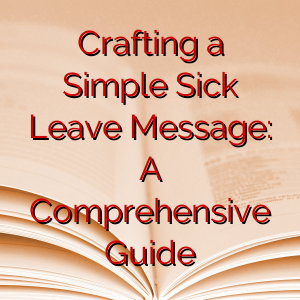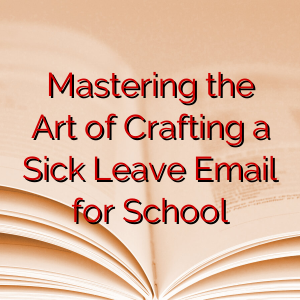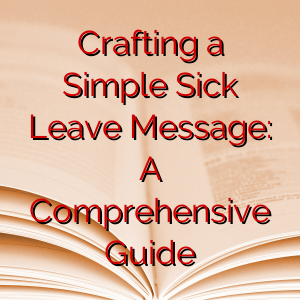How to Inform Sick Leave | A Comprehensive Guide
Navigating workplace communication is crucial, especially when it comes to sensitive topics like sick leave. Understanding how to inform sick leave in a professional, clear, and concise manner can help maintain a positive relationship with your employer, reassure your team, and ensure a stress-free recovery period for you.
What is Sick Leave and Why is it Important to Inform it Properly?
Sick leave is a type of leave that allows employees to take time off from work due to illness. Ensuring you communicate your sick leave effectively is essential for keeping your team informed, allowing for necessary adjustments in workload, and respecting your workplace’s protocols. A well-written sick leave notice ensures understanding and minimizes potential disruption in your workplace.
class="font-bold text-gray-800 text-h3 leading-[36px] pt-[21px] pb-[2px] [&_a]:underline-offset-[6px] [&_.underline]:underline-offset-[6px]" dir="ltr">How to Write a Sick Leave Notification
Start with a Clear Subject Line
In your email, use a clear and concise subject line like “Sick leave notification for [dates].”
Be Precise and Informative
Include all the necessary details such as your leave’s start and end dates, a brief explanation of your situation (only if you’re comfortable), and how you’ve planned for your absence in terms of work delegation.
Maintain Professionalism
Remember to maintain a formal tone and thank your employer for their understanding and consideration of your situation.
Examples of Sick Leave Notifications
1. For Flu
Subject: Sick Leave Notification for [Start Date] to [End Date].
Dear [Manager’s Name], I regret to inform you that I’ve come down with the flu and my doctor has advised rest for a few days. I’ve delegated my tasks to [colleague’s name] during my absence. Thank you for your understanding.
2. For Surgery
Subject: Medical Leave Notification for [Start Date] to [End Date].
Dear [Manager’s Name], I will be undergoing surgery and hence need to take sick leave. My tasks will be handled by [colleague’s name] in my absence. I appreciate your support during this time.
3. For COVID-19
Subject: Self-Isolation Leave Notification for [Start Date] to [End Date].
Dear [Manager’s Name], I’ve tested positive for COVID-19 and am currently in self-isolation. I’ve arranged for [colleague’s name] to cover my duties until I recover. Thank you for your understanding and support.
4. For Mental Health
Subject: Mental Health Leave Notification for [Start Date] to [End Date].
Dear [Manager’s Name], I will be taking a few days off to focus on my mental well-being. I’ve delegated my responsibilities to [colleague’s name] during my absence. I appreciate your understanding.
FAQs on Informing Sick Leave
Q1: Is it necessary to specify my illness in the sick leave notification?
A: It’s not mandatory to disclose the specifics of your illness. You can choose to share details based on your comfort level and the culture of your workplace.
Q2: When should I send my sick leave notification?
A: Send your sick leave notification as soon as you realize you’re unable to attend work. This allows your team to make necessary adjustments in a timely manner.
Q3: Can I send my sick leave notification via email?
A: Yes. Most workplaces prefer email notifications as they provide a written record, are faster, and more efficient.
Conclusion
Knowing how to inform sick leave is a valuable skill in the professional world. This guide aimed to provide you with concrete examples, clear guidelines, and answers to common questions to help you communicate effectively with your superiors. The key lies in clear, respectful, and timely communication that takes into account the needs of your colleagues as well as your own health.

Hello! Welcome to my Blog StudyParagraphs.co. My name is Angelina. I am a college professor. I love reading writing for kids students. This blog is full with valuable knowledge for all class students. Thank you for reading my articles.




